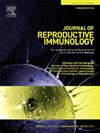Chebulagic acid inhibits lipopolysaccharide-induced endometritis by regulating mitogen-activated protein kinase/nuclear factor-κB signaling
IF 2.9
3区 医学
Q3 IMMUNOLOGY
引用次数: 0
Abstract
This study investigates the potential protective effects of chebulagic acid (CA) against endometritis and its underlying molecular mechanisms. Network pharmacology analysis identified 19 potential targets of CA related to endometritis, mainly associated with the mitogen-activated protein kinase (MAPK) signaling pathways. Molecular docking analysis further indicated that MAPK14 and MAPK3 are critical targets of CA, suggesting its potential role in modulating inflammatory responses. In vitro experiments demonstrated that CA at concentrations of 12.5, 25, and 50 µg/mL significantly inhibited the secretion of proinflammatory cytokines interleukin (IL)-1β and IL-6 in lipopolysaccharide (LPS)-stimulated bovine endometrial epithelial cells (bEECs), without affecting cell viability. In vivo, CA treatment mitigated uterine inflammation in an LPS-induced mouse model of endometritis by downregulating high-mobility group box protein 1 (HMGB1) expression and inhibiting the phosphorylation of key signaling molecules, including p65, extracellular signal-regulated kinase (ERK), and p38. These findings suggest that CA exerts significant anti-inflammatory effects in endometritis by modulating the MAPK/NF-κB signaling pathway. Given its potential to suppress excessive inflammatory responses, CA may serve as a promising candidate for the development of novel therapeutic strategies for endometritis.
乳脂酸通过调节丝裂原活化蛋白激酶/核因子-κB信号通路抑制脂多糖诱导的子宫内膜炎
本研究探讨了chebulagic acid (CA)对子宫内膜炎的潜在保护作用及其潜在的分子机制。网络药理学分析确定了19个与子宫内膜炎相关的CA潜在靶点,主要与丝裂原活化蛋白激酶(MAPK)信号通路相关。分子对接分析进一步表明,MAPK14和MAPK3是CA的关键靶点,提示其在调节炎症反应中的潜在作用。体外实验表明,12.5、25和50 µg/mL浓度的CA可显著抑制脂多糖(LPS)刺激的牛子宫内膜上皮细胞(bEECs)中促炎细胞因子白细胞介素(IL)-1β和IL-6的分泌,而不影响细胞活力。在体内,CA治疗通过下调高迁移率组盒蛋白1 (HMGB1)的表达和抑制关键信号分子的磷酸化,包括p65、细胞外信号调节激酶(ERK)和p38,减轻了lps诱导的子宫内膜炎小鼠模型的子宫炎症。这些结果提示CA通过调节MAPK/NF-κB信号通路在子宫内膜炎中发挥显著的抗炎作用。鉴于其抑制过度炎症反应的潜力,CA可能是开发子宫内膜炎新治疗策略的有希望的候选者。
本文章由计算机程序翻译,如有差异,请以英文原文为准。
求助全文
约1分钟内获得全文
求助全文
来源期刊
CiteScore
6.30
自引率
5.90%
发文量
162
审稿时长
10.6 weeks
期刊介绍:
Affiliated with the European Society of Reproductive Immunology and with the International Society for Immunology of Reproduction
The aim of the Journal of Reproductive Immunology is to provide the critical forum for the dissemination of results from high quality research in all aspects of experimental, animal and clinical reproductive immunobiology.
This encompasses normal and pathological processes of:
* Male and Female Reproductive Tracts
* Gametogenesis and Embryogenesis
* Implantation and Placental Development
* Gestation and Parturition
* Mammary Gland and Lactation.

 求助内容:
求助内容: 应助结果提醒方式:
应助结果提醒方式:


